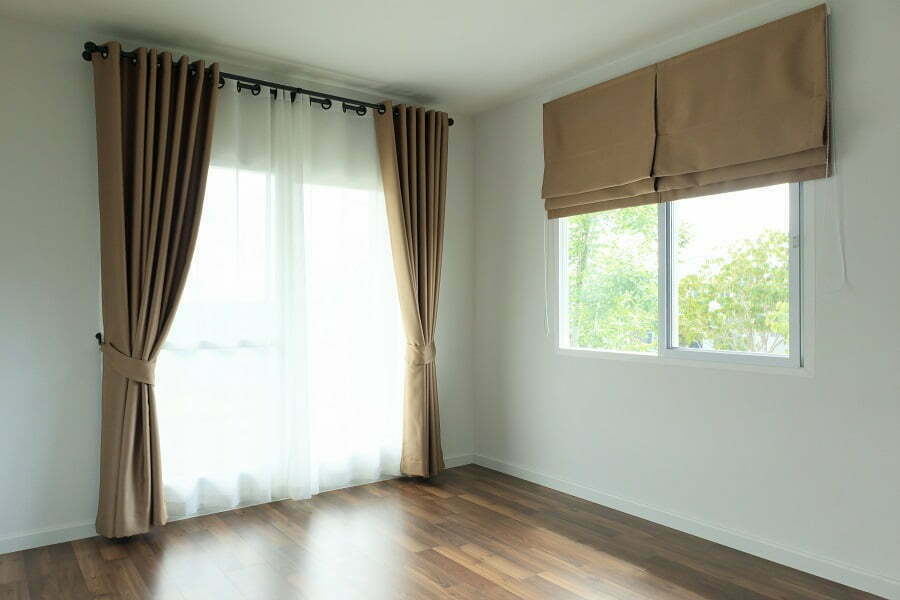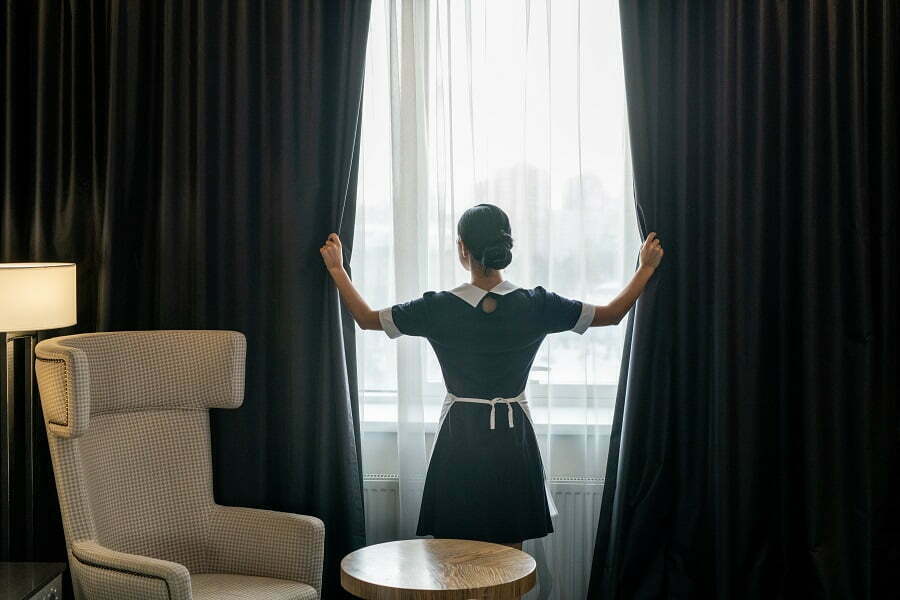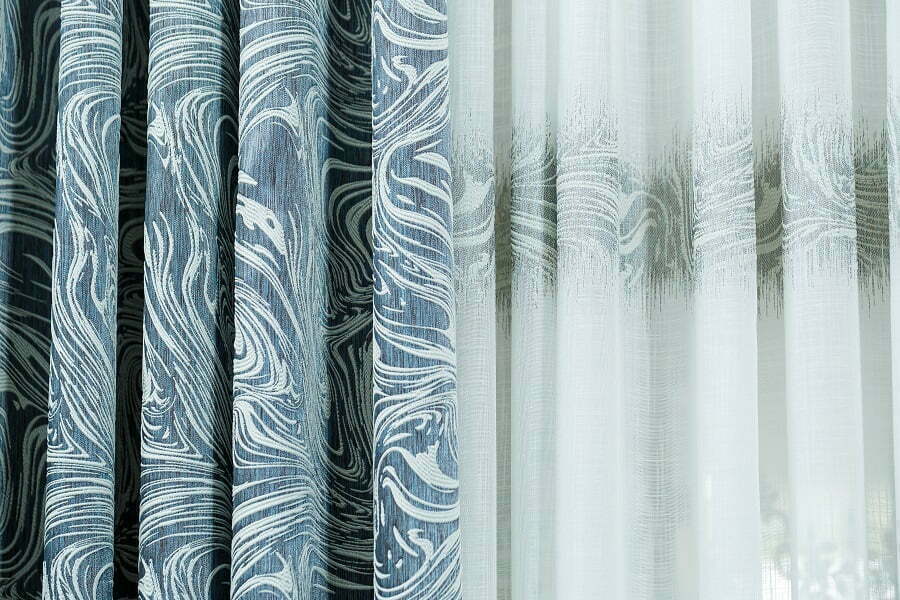Last updated on
So it comes down to the choice between the blackout and thermal curtains. Is it enough to block the light, or should you choose to insulate the room too? What’s the difference?
The main difference between the blackout (including room darkening) and thermal curtains is how thick they are and how many layers they have. While these types of curtains are similar, they differ in the main goal they try to achieve.
The purpose of blackout curtains is to block all light coming in through the window. Meanwhile, the thermal curtains try to block air circulation, thus insulating the window. It means the former need to have an extra layer of insulation.
Let’s look at all of these differences in more detail.
The Blackout Curtains

Blackout curtains are a type of window covering that blocks out light from entering your home. They are also called “light-blocking” curtains because they block out all visible light, including both natural daylight and artificial lighting coming from the outside. They are made of thick fabric, so they provide some insulation.
The Thermal Curtains

Thermal curtains are a type of curtain that prevents heat leaks to keep you warm in cold weather. A thermal curtain is usually made of two layers of heavy cloth backed by an insulation layer and then covered with a thin film to prevent moisture from passing through.
Thermally insulated curtain panels usually (statistically) consist of 100 percent cotton, wool, or polyesters, covered by an outer coating of acrylic foam or aluminum foil to keep out UV rays. Because they’re made out of thick batting, these curtains muffle sounds coming into the room. Naturally, being so thick, they block out all the light too; thus, you can use them as a blackout curtain alternative.
The Differences Between Thermal Curtains and Blackout Curtains
The main difference between blackout curtains and thermal curtains is that thermal curtains use an extra layer of insulation to keep you warm while blocking out sunlight and other forms of light.
Blackout curtains block out most outside light, so they don’t let light into your home. They can be used in rooms where you want to sleep but not have a bright light shining on you at night. Blackout curtains are great for bedrooms, living rooms, offices, and many more places.
Thermal curtains work by using a special fabric with reflective properties. The fabric blocks air circulation and keeps the cold air out and warm air in. This keeps you warm even when it’s cold outside.
Noise Reduction
Thermal curtains reduce noise by providing a better sound barrier than blackout curtains. So, these curtains are designed to keep you warm without letting too much noise in. If you’re looking for a way to keep your house quieter, then consider installing thermal curtains instead of traditional blinds.
Triple Weave Fabric
Both blackout and thermal curtains are usually made out of triple weave fabric. Triple weave fabrics are woven three times over each thread, creating a thicker and stronger material. This means that thermal curtains will last longer than regular curtains.
Do Thermal Curtains Save Energy?
Whether or not a thermal curtain saves energy has been asked for years. The answer depends on the type of window you have and how much heat it loses through the glass.
Thermal curtains are made of thick material that allows very little light to pass through. This means that even though the curtains might be open during daylight hours, they still keep out the sun’s rays. They also help reduce the amount of heat lost through the glass.
If you live in a cold climate, where temperatures drop well below freezing, thermal curtains will help prevent drafts from entering your house. In addition, when the temperature rises above 85 degrees Fahrenheit, thermal curtains will help keep the air in your home cool.
If your home does not experience extreme weather conditions, you probably won’t notice any difference in heating costs. However, if you live in a warmer area, thermal curtains could help you save money on cooling costs.
Layering Blackout vs. Thermal Curtains
When hanging curtains, it is important to use layers of fabric. Layers give the illusion of depth and make the curtains appear thicker than they actually are. When choosing fabrics for curtains, choose similar ones in weight and texture.
For example, if you were going to buy a sheer curtain, you wouldn’t want to purchase heavy cotton sheeting because it would look too much like a shower curtain. Instead, you would want to buy something like silk or chiffon.
When hanging a single layer of material, place the center fold along the middle of the rod. This way, the folds will fall evenly across the entire rod. You should also try to avoid placing the centerfold directly over the rod. Doing this creates a “V” shape which makes the curtain look thinner than it really is.
When using multiple layers of material, start by folding up the top layer of material. Place the center fold along the top of the rod and add additional layers until you reach the desired amount of thickness. Try to keep the layers as even as possible.
If you want to go all out, you can even use different materials within the same curtain. For example, you could use a heavier material for the bottom of the curtain and lighter material for the top.
What’s The Difference?
The most common question we receive when people ask about curtains is whether to have blackout curtains or thermal curtains. Both styles offer benefits and drawbacks. We’ve put together some information about both options to help you decide what style is best for your home.
Blackout Curtains
The first thing you need to know about blackout curtains is that they don’t allow any light through. They are designed to block out sunlight completely. While this does provide many benefits, there are some downsides as well. Because these curtains block out light, you won’t see outside while inside. This means that you’ll have to rely on natural lighting instead of artificial lighting. It also means that you won’t see anything happening outside your window.
Thermal Curtains
Thermal curtains are just like blackout curtains as far as blocking the light. But they introduce another layer of insulation to keep the room warmer during the winter or cooler during the summer. That’s a big advantage over the blackout curtains that aren’t well insulated. The drawback is that thicker and heavier thermal curtains are more difficult to style and layer.
Grommets
One of the biggest differences between blackout and thermal curtains is how they’re hung. Thermal curtains are usually hung using grommet holes. Grommets make it easy to hang thermal curtains because they are already attached to the curtain rods. However, if you choose to buy blackout curtains, you’ll have to purchase new curtain rods.
In addition to providing convenience, grommets also make thermal curtains safer. If someone were to trip and fall onto a thermal curtain, the grommets would prevent the person from falling through the curtain. However, with blackout curtains, the risk of injury is higher because the curtain doesn’t contain any safety features.
Curtain Rods
There are two main types of curtain rods used for either type of curtain. For blackout curtains, you can use standard curtain rods. Standard curtain rods are made of metal and are meant to hold heavy fabrics. This means that they are strong enough to support the weight of the curtain.
For thermal curtains, you should not use telescopic curtain rods. Telescoping rod systems are designed specifically to hold lightweight materials. This means that they won’t support the weight of heavier fabrics. Instead, you’ll need to use special brackets to attach the curtain to the rod.
FAQ
You can see out your windows if you pull the blackout curtain back. If they are closed, you will not see out because blocking the light works both ways.
There isn’t really a set rule for how long you should keep your curtains open. Some people recommend leaving them open 24/7, while others suggest keeping them closed at night and opening them up during the day. We advise trying different things until you find something that works for you.
You can easily wash thermal curtains. Simply hand wash them using mild soap and rinse thoroughly. Do not use bleach or other harsh chemicals. Follow the manufacturer’s directions to wash your specific curtains.
Recap
Liked this article? Here's what you can read next:





